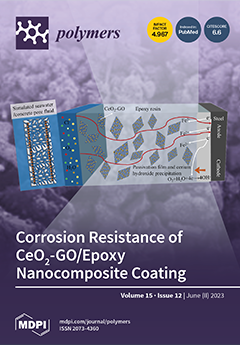Tribo-mechanical experiments were performed on Glass Fiber Reinforced Polymer (GRFP) composites against different engineering materials, and the tribological behavior of these materials under dry conditions was investigated. The novelty of this study consists of the investigation of the tribomechanical properties of a customized
[...] Read more.
Tribo-mechanical experiments were performed on Glass Fiber Reinforced Polymer (GRFP) composites against different engineering materials, and the tribological behavior of these materials under dry conditions was investigated. The novelty of this study consists of the investigation of the tribomechanical properties of a customized GFRP/epoxy composite, different from those identified in the literature. The investigated material in the work is composed of 270 g/m
2 fiberglass twill fabric/epoxy matrix. It was manufactured by the vacuum bag method and autoclave curing procedure. The goal was to define the tribo-mechanical characteristics of a 68.5% weight fraction ratio (wf) of GFRP composites in relation to the different categories of plastic materials, alloyed steel, and technical ceramics. The properties of the material, including ultimate tensile strength, Young’s modulus of elasticity, elastic strain, and impact strength of the GFPR, were determined through standard tests. The friction coefficients were obtained using a modified pin-on-disc tribometer using sliding speeds ranging from 0.1 to 0.36 m s
−1, load 20 N, and different counter face balls from Polytetrafluoroethylene (PTFE), Polyamide (Torlon), 52,100 Chrome Alloy Steel, 440 Stainless Steel, and Ceramic Al
2O
3, with 12.7 mm in diameter, in dry conditions. These are commonly used as ball and roller bearings in industry and for a variety of automotive applications. To evaluate the wear mechanisms, the worm surfaces were examined and investigated by a Nano Focus—Optical 3D Microscopy, which uses cutting-edge μsurf technology to provide highly accurate 3D measurements of surfaces. The obtained results constitute an important database for the tribo-mechanical behavior of this engineering GFRP composite material.
Full article






